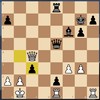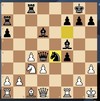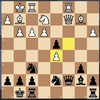Tactics 1-50 Flashcards
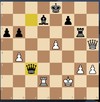
+7.85 2. Qh8+ Ke7 3. Rxd7+ Kxd7 4. e6+ Rxe6 5. Qxc3

Both g6 and h6 lead to a mating pattern, but h6 allows K to be attacked by Rh1.
So answer is g6

28. Qe3! Qe7
- ..Qxe3 29. Rxf8#
- Rxf8+ Qxf8
30. Qxa7+-
Learning points - this was use of alignment (Black Q+R) and tempo move to gain time.
Always follow through to opponents next forcing move unless checkmate

1… Re2! 2. Rxe2
2.Qxd4 Rxe1+3. Rxe1 Rxe1#
Chessable Note: After2. Be3 only2…2 Rxe3 and 2…8Rxe3 work because2…Nxe3 is answered by either 3. Qxd4 or3.Qxe2
2… Qxa1+ 3. Qc1 Qxc1+ 4. Bxc1 Rxe2-+
0-1
learning point - no check so need to calculate all variations

43. Rxf8+! Kxf8 44. Qh8+ Qg8 45. Rxe8+ Kxe8
45…R xe8,46. Qf6+ Almost an epaulette mate!46…Qf7 47.Qxf7#
46. Qxg8+ Kd7 47. Qd5+ Ke8
- ..K c8 48. Qf5+ Kd8 49. Qxc2+-
- ..Kc7 48.Qxc5+ Kd7 49. Qxc2+-
48. Qa8+ Kd7 49. Qa4+ Kd6 50. Qxc2+-
Learning point - keep in mind whole board including past pawns

1. Qc3! Qb4 2. Ne7+ Qxe7
- ..Nxe7 3. Qxb4+-
- ..Kh7 3. Nxc6+-
3. Qxg7#
Learning point - be careful of exposed K as they often give chance of a counter attack

1.Rxg6+ fxg6 2. Qxg6+ Kf8 3. Rf3+ Ke7 4. Rf7+ Kd8 5. Qf6+ Ke8 6. Qe7#
- .. Kh8 3. Rg3 Qd7
- .. Kh7 5. Qh4#
- .. Qg7 5. Qxg7#
Learning point: Q can often check from more positions. In this case a different check is better than the lawn mower.

1… Bh3 2. Nb5 Bg2 3. Nxc7+ Ke7 4. Nd5+ cxd5 5. Qxf3 Bxf3 6. Bh6 to mate
Learning point: dont run to place Queen (here attacked by B) and consider most threatening opponents counter attacks - N looking for checks or Queen sacrifices

1. Rc1 g6 2. Rc8 Qxc8 3. Qxc8+
Learning point: Alignments should be searched for vertically, diagonally and horizontally

3.60 1. Bb6 Qc8 2. Qxe4
Learning point: consider that attacks and hanging pieces can combine to give a tactic.

- Bxg7
there are several responses as there is no check
Engine gives
9.02 1. Bxg7 Re6 2. Bxf6 Qb4 3. Qg5+ Kf8 4. c3 Qd6
Learning point: consider sacrificing piece to take pawns in front of K if you have a strong attack afterwards
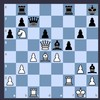
Best response
5.51 1. Nd7 Rfe8 2. Nxb8 Qxb8
however if QxN then BxB and the Q is lost
Learning point: look to create alignment through tactics and then use the alignment.

-7.57 1… Rxf2 2. Qxf2 Be3 3. Qxe3 Qxe3+
Learning point: sacrifice for pawns in front of King. If Q doesn’t take rook there is anyway a discovered attack on K with loss of Q
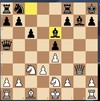
- Rg1 Bf6 3. Bh6 Qxc3+
Learning point: Bg5 does not work as B will be pinned on Rg8

- Nxc6 Qb4+ 3. Nxb4 Bxb4+
If retakes with pawn then Boden’s mate
Learning point: Not an easy pattern to spot. Look at open DSB diagonal and K is unable to move to right/(left) due to own pieces.

14… Nc3 15. Qe1 Nc2 16. Bc4 Nxe1 17. Rfxe1
Learning point: the Queen Bishop pattern creates an opportunity if there is a Knight in forking distance

